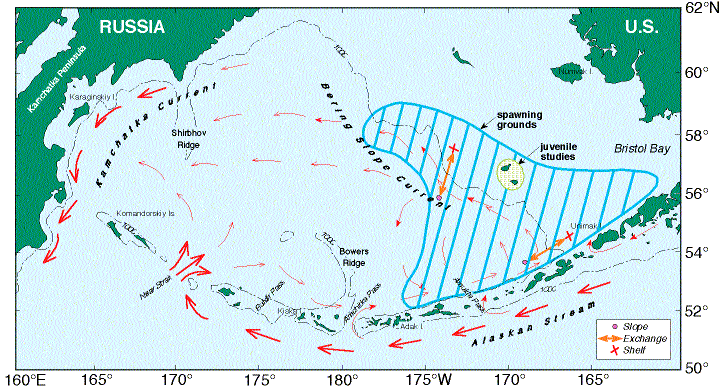Southeast Bering Sea Carrying Capacity Regional
Ecosystem Study
ISSUE
Approximately forty percent of the total U.S. commercial fishery
landings by weight comes from the Bering Sea. Pollock
abundance in the southeast Bering Sea has declined significantly since the
mid- l980's with population levels fluctuating widely since the 1960's. This
multi- billion dollar U.S. fishery is fully utilized and fluctuations in abundance
are immediately felt by the industry. Past studies have indicated that pollock
larvae are a key component in the food web, and that the deep basin of the
Bering Sea may not be able to maintain the abundance of larval fish needed
to sustain the fishery and the feeding of top predators such as marine mammals
and seabirds. Fisheries scientists and managers require better information
to determine the integrated role of fishing pressure and changing environmental
factors on Bering Sea resources, and to understand key ecosystem linkages.
A management system tuned to the ecosystem "as a whole" is needed to manage
resource levels, resolve utilization conflicts, and sustain this valuable
ecosystem.
NOAA's Coastal Ocean Program (COP) is responding to this need
by supporting the Southeast Bering Sea Carrying Capacity (SEBSCC) Regional
Ecosystem Study. SEBSCC researchers are increasing the understanding of the
southeastern Bering Sea ecosystem, documenting the role of juvenile walleye
pollock and factors that affect their survival, and developing and testing
annual indices of pre-recruit (age-1) pollock abundance. The SEBSCC study
is administered by the Pacific
Marine Environmental Laboratory, the University
of Alaska, and the Alaska
Fisheries Science Center.
Spawning Grounds of Bering Sea Walleye Pollock

APPROACH
COP research has
focused on pollock distribution and physical processes in the Bering Sea,
and has evolved to support an integrated multi-disciplinary program of modeling,
process studies, observations, and environmental valuation to improve the
understanding and management of coastal and living resources, particularly
in the context of integrated resource management. Current research efforts
are focusing on understanding the linkages among environmental factors, recruitment,
growth rates, predation and distribution of key fisheries, and other components
of the Bering Sea ecosystem, with a special emphasis on the southeastern Bering
Sea shelf.
ACCOMPLISHMENTS
Over the past several
years, COP researchers have greatly advanced the stock structure definition
of Bering Sea pollock through determination of basin circulation, analysis
of recent and historical survey data, and development of genetic testing methods.
The research findings have shown that there are significant differences in
genetic structure between fish from the eastern and western portions of the
Bering Sea, which has helped support improved stock allocations and international
agreements.
Conditions in the
Bering Sea in 1997 were remarkable in that an extensive summer bloom of coccolithophores
(unicellular organisms with white calcareous coatings) developed, making the
waters appear turquoise to milky white, and leading to decreased visibility
through the water column. This was coincident with extensive die-offs of short-tailed
shearwaters, and low salmon returns to Bristol Bay, Alaska. SEBSCC researchers
were in the field to monitor conditions leading to the bloom, document the
extent of the bloom, and compare bloom conditions to data from previous years.
Subsequent field studies in 1998 and 1999 found that the coccolithophore bloom
recurred, although physical conditions were quite different. Data is being
analyzed to determine if causes can be identified, leading to predictive capabilities
for such large ecosystem changes.
SEBSCC researchers have recently developed a new hypothesis
for the control of energy flow in the Southeastern Bering Sea, termed the
Oscillating Control Hypothesis, based on relationships between the timing
of ice retreat and the occurrence of ice-edge vs. open-water phytoplankton
blooms. When sea-ice remains relatively late in the year (late March), an
ice-edge bloom develops, and the primary production is not translated into
high zooplankton production. This leads to fewer juvenile pollock being supported,
and is evidence of bottom-up control on production in the Bering Sea. During
years when the ice-edge retreats relatively early (prior to mid-March), an
open water phytoplankton bloom develops, which can fuel zooplankton production
and support high juvenile pollock numbers. This leads to a top-down control
on pollock production, as adult pollock are cannibalistic on juveniles. The
Oscillating Control Hypothesis, if proven, has profound implications for year-class
strength of pollock, and the management of the pollock fishery in the Southeast
Bering Sea.
Related Websites
For more information contact:
Elizabeth Turner
CSCOR/Coastal Ocean
Program
phone: 301-713-3338
e-mail: coastalocean@noaa.gov
Last Updated:
October 31, 2002



